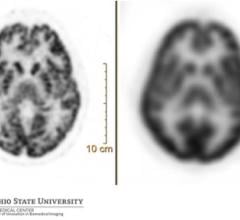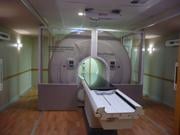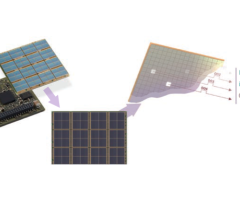November 17, 2010 — A five-year, $10 million grant supporting a leading-edge molecular imaging center at UCLA has been ...
PET Imaging
Positron emission tomography (PET) is a nuclear imaging technology (also referred to as molecular imaging) that enables visualization of metabolic processes in the body. The basics of PET imaging is that the technique detects pairs of gamma rays emitted indirectly by a positron-emitting radionuclide (also called radiopharmaceuticals, radionuclides or radiotracer). The tracer is injected into a vein on a biologically active molecule, usually a sugar that is used for cellular energy. PET systems have sensitive detector panels to capture gamma ray emissions from inside the body and use software to plot to triangulate the source of the emissions, creating 3-D computed tomography images of the tracer concentrations within the body.
November 15, 2010 — The Radiology journal released new data from an National Institutes of Health (NIH)-sponsored ...
November 10, 2010 – During RSNA 2010, GE Healthcare will announce the availability of the Discovery NM/CT 670, an ...
Digital technology is opening remarkable opportunities for clinical positron emission tomography (PET) about which ...
Launching a new cancer center can be a long process, taking several months or even years to see a return on investment ...
November 9, 2010 – In an effort to further promote the utility of PET/CT (positron emission tomography/computed ...
November 4, 2010 – GE Healthcare has signed an exclusive collaboration agreement with West Physics Consulting to provide ...
Precision can have an enormous impact on patients. From diagnosis to patient monitoring (see “How Digital PET/CT Can ...
October 27, 2010 – A new digital silicon photomultiplier technology has been developed with applications in both X-ray ...
October 19, 2010 — CardioGen-82 (Rubidium Rb 82 Generator) when used with positron emission tomography (PET) myocardial ...
October 19, 2010 – A new high-definition (HD) technology reduces blur created by respiration during positron emission ...
PET is getting ready to venture outside oncology, cardiology and mainstream neurology. High on the list of new clinical ...
October 8, 2010 — The Ivy Model 3000 Series Cardiac Trigger Monitor offers precision image-triggering nuclear medicine ...
October 5, 2010 — The Society of Nuclear Medicine’s Molecular Imaging Center of Excellence (MICoE) changed its name ...
As production of molybdenum-99 returns to normal with the Canadian Chalk River Laboratories reactor back online and the ...
Analog is approximate. Digital is specific. Therein lies the fundamental difference between digital PET and its analog ...
September 29, 2010 — In a prospective study published in the European Journal of Nuclear Medicine and Molecular Imaging ...
September 8, 2010 — A series of studies published in the September Journal of Nuclear Medicine (JNM) show that molecular ...
September 1, 2010 - Two devices in one is one of the mega trends in imaging diagnostics. The spectrum ranges from a ...
August 30, 2010 – A portfolio of advanced quantification solutions for 2-D and 4-D ultrasound imaging were added to ...
August 23, 2010 — The Intego positron emission tomography (PET) infusion system is now listed with Novation LLC, one of ...
In scientific research, sometimes simply connecting two points with a line is enough to paint the big picture. When ...
August 24, 2010 - In a recent study presented at the American Association of Physicists in Medicine (AAPM) 52nd Annual ...
August 23, 2010 - A new, rapid method of labeling peptides with a fluorine-18 (F-18) positron-emission tomography (PET) ...

 November 17, 2010
November 17, 2010 











